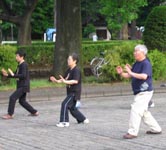Low-impact exercise forms may raise incidence of low bone density

Washington, Oct 17 : Researchers from the University of Missouri-Columbia have discovered that men engaging predominantly in low-impact forms of exercise have an increased incidence of osteopenia, a condition resulting in two times the risk of bone fracture.
For the study, the researchers measured bone mineral density in 43 competitive male cyclists and runners ages 20 to 59.
The findings of the study showed that the cyclists had significantly lower bone mineral density of the whole body, especially of the lumbar spine, compared to runners. Examination showed that 63 percent of the cyclists had osteopenia of the spine or hip compared with 19 percent of the runners and cyclists, who were seven-times more likely to have osteopenia of the spine than the runners.
Pamela Hinton, an associate professor of nutritional sciences in MU's College of Human Environmental Sciences, co-author of the study, said that the effects of osteopenia could be mitigated by integration of weight-bearing activities into the lifestyle of active individuals.
"Regular, non-weight-bearing activities, such as swimming and cycling are effective measures for preventing the leading risk factors for death and disability in our society. But the results of this study suggest that regular weight-bearing activities, such as running, jogging, or rope jumping, are important for the maintenance of healthy bones," Hinton said.
The risk of fracture is increased approximately two-fold in osteopenic individuals and five-fold in people with osteopenia, she added.
Low bone density in males often remains undiagnosed and inadequately treated and, after suffering a fracture, men are less likely to receive follow-up care than women.
The new study will be published in the journal, Metabolism. (ANI)